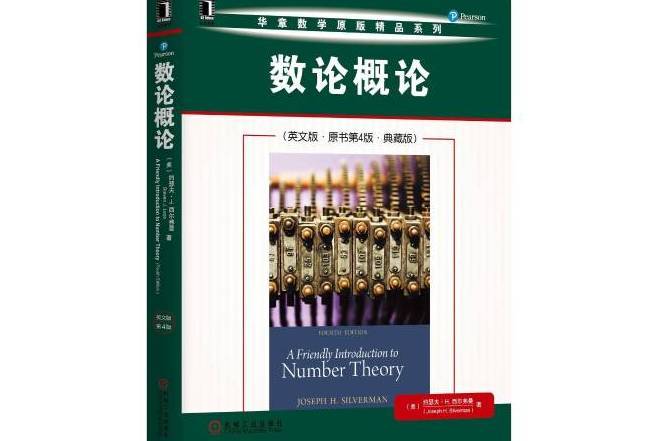《數論概論:英文版》是2020年機械工業出版社出版的圖書。
基本介紹
- 中文名:數論概論:英文版
- 作者:(美)約瑟夫·H.西爾弗曼(JosephH.Silverman)
- 出版時間:2020年
- 出版社:機械工業出版社
- ISBN:9787111645009
內容簡介,圖書目錄,
內容簡介
本書面向非數學專業學生,講述了有關數論的知識,教給他們如何用數學方法思考問題,同時介紹了目前數論研究的某些前沿課題。與第3版相比,本版的具體更新如下: 新增一章,詳細介紹數學歸納法(第26章);前言部分給出了各章之間依賴關係的流程圖,便於讀者選擇閱讀;調整了內容的組織結構,將反證法的相關材料前移至第8章,原根的相關章節移至二次互反律與平方和之後,第47~50章的內容移至網上;給出了二次互反律的完整證明,以及雅可比符號二次互反律的部分證明(第23章);更新了書中的實例及章後習題。
圖書目錄
引言 1
第1章 什麼是數論 6
第2章 勾股數組 13
第3章 勾股數組與單位圓 21
第4章 高次冪之和與費馬大定理 26
第5章 整除性與公因數 30
第6章 線性方程與公因數 37
第7章 因數分解與算術基本定理 46
第8章 同餘式 55
第9章 同餘式、冪與費馬小定理 65
第10章 同餘式、冪與歐拉公式 71
第11章 歐拉函式與中國剩餘定理 75
第12章 素數 83
第13章 素數的計數 90
第14章 梅森素數 96
第15章 梅森素數與完全數 101
第16章 冪模m與逐次平方法 111
第17章 計算模m的k次根 118
第18章 冪、根與不可破密碼 123
第19章 素性測試與卡米歇爾數 129
第20章 模p平方剩餘 141
第21章 –1是模p平方剩餘嗎?2呢 148
第22章 二次互反律 159
第23章 二次互反律的證明 171
第24章 哪些素數可表成兩個平方數之和 181
第25章 哪些數能表成兩個平方數之和 193
第26章 像1, 2, 3一樣簡單 199
第27章 歐拉函式與因數和 206
第28章 冪模p與原根 211
第29章 原根與指標 224
第30章 方程X4 Y4=Z4 231
第31章 再論三角平方數 236
第32章 佩爾方程 245
第33章 丟番圖逼近 251
第34章 丟番圖逼近與佩爾方程 260
第35章 數論與虛數 267
第36章 高斯整數與因子分解 281
第37章 無理數與超越數 297
第38章 二項式係數與帕斯卡三角形 313
第39章 斐波那契兔子問題與線性遞歸序列 324
第40章 O,多美的一個函式 339
第41章 三次曲線與橢圓曲線 353
第42章 有少量有理點的橢圓曲線 366
第43章 橢圓曲線模p上的點 373
第44章 模p的撓點系與不好的素數 384
第45章 虧量界與模性模式 388
第46章 橢圓曲線與費馬大定理 394
進一步閱讀的文獻 396
Contents
Introduction......................................................... 1
1 What Is Number Theory?............................................. 6
2 Pythagorean Triples................................................. 13
3 Pythagorean Triples and the Unit Circle............................... 21
4 Sums of Higher Powersand Fermat’s Last Theorem.................... 26
5 Divisibility and the Greatest Common Divisor......................... 30
6 Linear Equations and the Greatest Common Divisor.................... 37
7 Factorization and the Fundamental Theorem of Arithmetic.............. 46
8 Congruences........................................................ 55
9 Congruences,Powers, and Fermat’s Little Theorem..................... 65
10 Congruences,Powers, and Euler’s Formula............................ 71
11 Euler’s Phi Function and the Chinese Remainder Theorem.............. 75
12 Prime Numbers..................................................... 83
13 Counting Primes.................................................... 90
14 Mersenne Primes.................................................... 96
15 Mersenne Primes and Perfect Numbers............................... 101
16 Powers Modulom and Successive Squaring........................... 111
17 Computing k th Roots Modulom ..................................... 118
18 Powers,Roots,and“Unbreakable”Codes............................ 123
19 Primality Testing and Carmichael Numbers........................... 129
20 Squares Modulo p .................................................. 141
21 Is.1 a Square Modulo p?Is 2?..................................... 148
22 Quadratic Reciprocity.............................................. 159
23 Proof of Quadratic Reciprocity...................................... 171
24 Which Primes Are Sums of Two Squares?............................ 181
25 Which Numbers Are Sums of Two Squares?.......................... 193
26 As Easyas One,Two,Three........................................ 199
27 Euler’s Phi Function and Sums of Divisors........................... 206
28 Powers Modulo p and Primitive Roots............................... 211
29 Primitive Roots and Indices......................................... 224
30 The Equation X 4 Y 4=Z 4 .......................................... 231
31 Square–Triangular Numbers Revisited............................... 236
32 Pell’sEquation .................................................... 245
33 Diophantine Approximation......................................... 251
34 Diophantine Approximation and Pell’s Equation...................... 260
35 Numb

